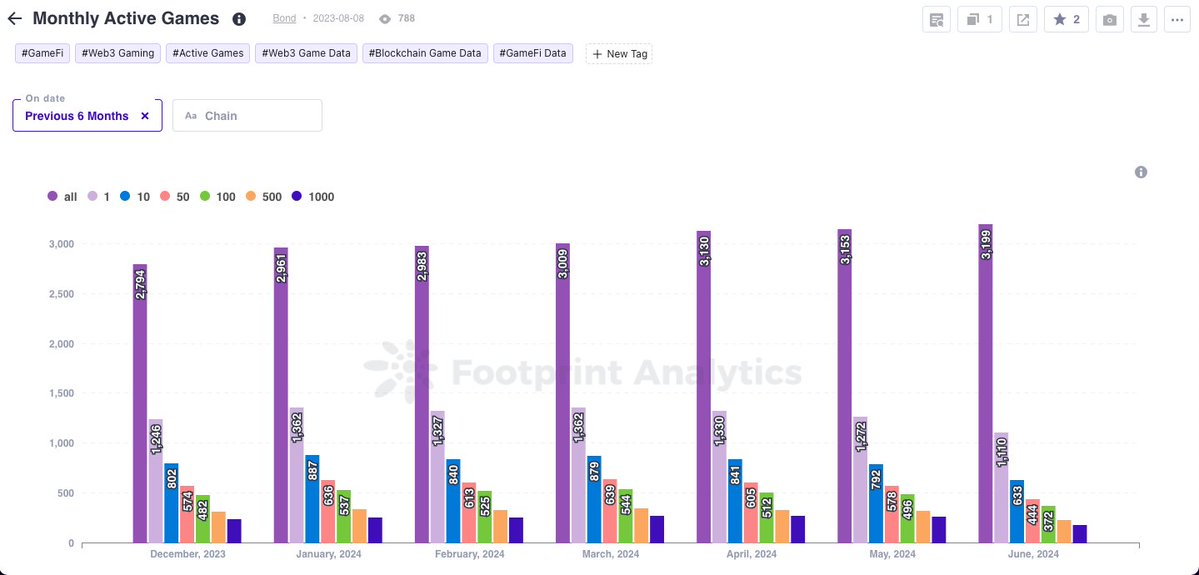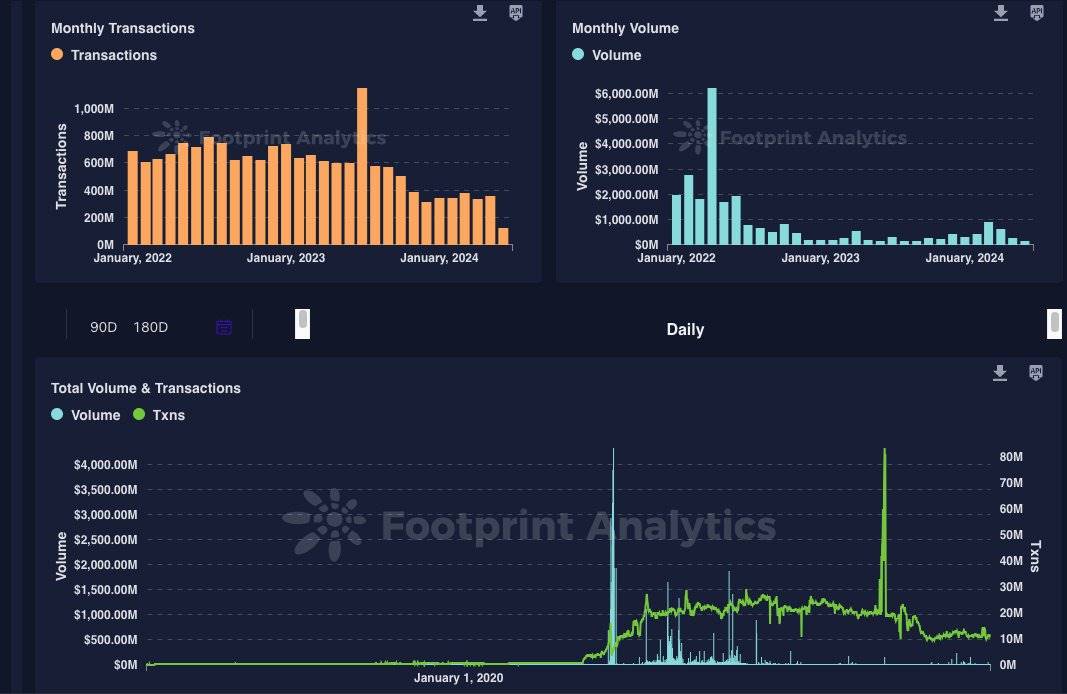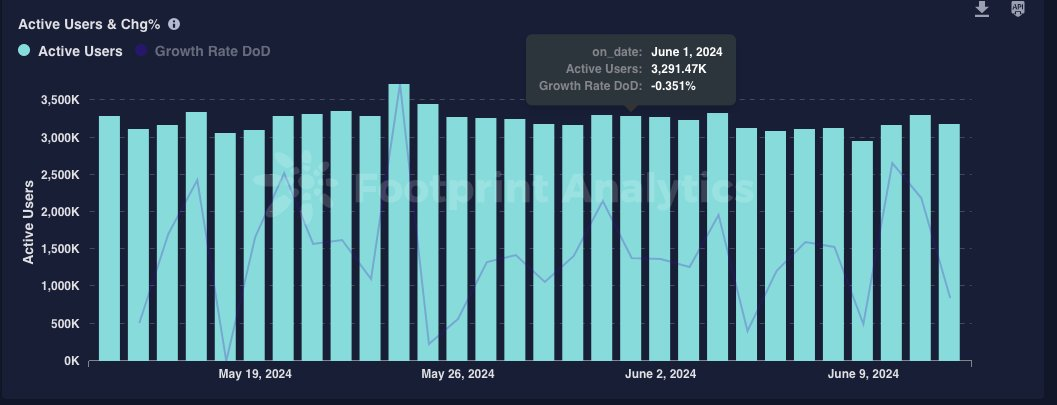Task
Ranking
已登录
Bee登录
Twitter 授权
TG 授权
Discord 授权
去签到
下一页
关闭
获取登录状态
My XP
0
0
+0
原作者: 足跡分析
原文翻譯:TechFlow
最近有一些關於區塊鏈遊戲是否已死的討論,雙方都有好的觀點。我們從數據角度來分析一下。
截至5月份,Footprint平台追蹤了3153款遊戲,其中每月活躍用戶(MAU)超過1000人的遊戲有263款,佔總數的8.2%。如果標準提高到10,000 MAU,這個數字將會大幅減少。需要注意的是,這些數據僅包括鏈上用戶。許多遊戲允許用戶無需登入錢包即可玩,同時仍包含 Web3 元素。目前這部分數據很難取得,可能會影響實際玩家數量的統計。
5月份,Web3遊戲日活躍用戶(DAU)成長9.6%,達到330萬用戶,但交易額較4月大幅下降(減少$3.90萬)。 DAU 的成長是一個好兆頭,但這種成長也應該伴隨著交易量的增加。交易量是衡量遊戲是否有趣、足以激勵玩家花錢的重要指標。不為遊戲做出貢獻的用戶更傾向於價值提取而不是投資。 5月份用戶平均遊戲時間與交易金額的相關性值得進一步探討。
近期實施的 玩並獲得空投 機制 遊戲中可能是造成這種現象的主要原因。雖然短期內效果良好,但長期來看可能會對專案產生負面影響。利用激勵吸引用戶留存的做法有助於指標的提升,但如果沒有紮實的遊戲基礎,空投後可能會出現代幣拋售,就像單一代幣經濟模型一樣,可能會導致無法挽回的死亡螺旋。
留存率是衡量遊戲樂趣程度的最佳指標之一 。在傳統的 Web2 遊戲中,保留的基準是: 第一天,30-40%; 20% 第 7 天;第 30 天,5-10% 。在 Web3 中,這些留存基準較難達到,但有些遊戲在第 7 天留存方面表現非常出色。這裡有一些 遊戲範例 擁有超過 50,000 名每日活躍用戶:
@ApeironNFT :86,987 日活躍用戶; 79.3% 第 7 天保留
@StarryNift :73,146 日活躍用戶; 70.8% 第 7 天保留
@pixels_online :900,569 日活躍用戶; 65.6% 第 7 天保留
@AxieInfinity :63,385 日活躍用戶; 42.1% 第 7 天保留
@九紀事 :83,360 日活躍用戶; 40% 第 7 天留存率(註:九編有自己的鏈,不依足跡索引)
根據上述遊戲的留存數據,認為Web3遊戲已死是錯誤的。如果不考慮其他指標,甚至可以推斷,Web3 遊戲在留存率方面比傳統基準測試表現更好。
投機 :潛在利潤的炒作掩蓋了遊戲的真正樂趣。
使用者體驗/介面 :目前Web3遊戲註冊流程冗長,介面複雜,使用困難,不美觀。
時間 :由於資源有限,遊戲往往在未完全打磨完之前就被迫發布。與傳統標準相比,Web3遊戲的開發時間更長,許多優秀的Web3遊戲尚未發布。
在這個階段, 說 Web3 遊戲已死既正確又錯誤。遊戲本質上是短暫的,這一點在 Web3 中尤其明顯 ,從活躍遊戲和非活躍遊戲的對比可以看出。 Web3 的每日活躍用戶最近創下歷史新高,但這些用戶是業界預期的用戶嗎?留存率很高,但僅限於少數遊戲,而且許多遊戲缺乏足夠的每日活躍用戶來真正衡量這一指標。最後,Web3 遊戲早期存在的許多問題仍然可見,但這些問題將隨著時間的推移而解決。此外,Telegram 上的迷你遊戲提供了快速有效地讓新用戶進入遊戲的好例子。 區塊鏈不需要徹底改變遊戲,它只需要改進它。
Web3遊戲並未消亡,Web3遊戲建設正在進行中…
本文源自網路:Web3遊戲資料解讀:活躍專案7天用戶留存率仍超40%
相關:Arthur Hayes:直到 8 月,比特幣將在 $60,000 和 $70,000 之間波動
原作者:Arthur Hayes 原文翻譯:GaryMa Wu 談區塊鏈 註:本文為原文章節選,部分細節或資訊可能會被刪除。我們建議讀者在閱讀本文時參考原文,以獲得更全面的資訊。自4月中旬以來,一些degens因看到加密市場的持續下滑而大喊“五月危機”。價格走勢符合我的預期。美國報稅季、對未來聯準會政策的擔憂、比特幣減半事件以及美國比特幣 ETF 資產管理 (AUM) 增長放緩,這些因素結合在一起,在前兩週引發了急需的市場清理。投機者或短線投資者,他們可能會選擇暫時退出市場,觀望接下來會發生什麼。


